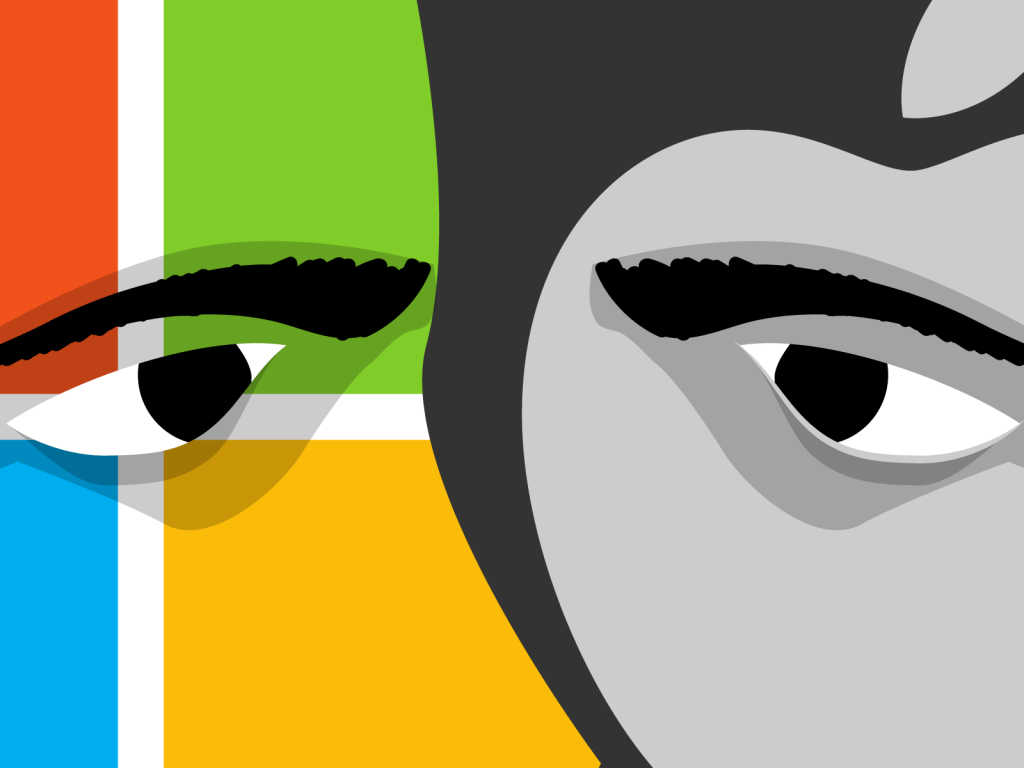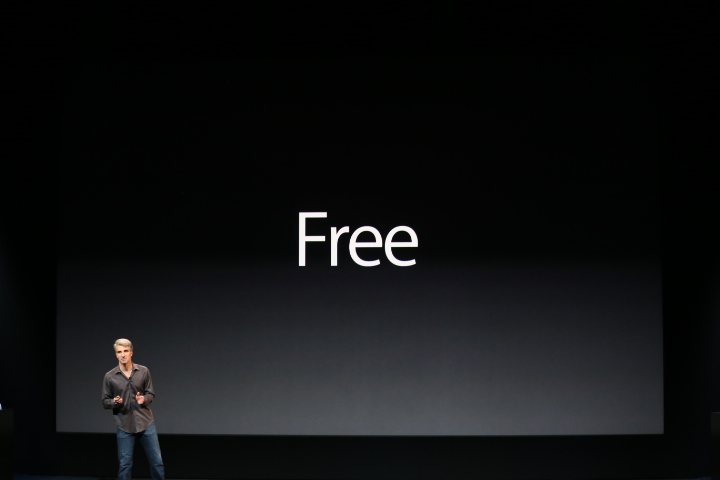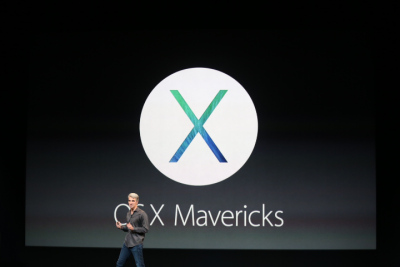Apple announced this week that it will make its iWork suite of productivity applications free on new OS X and iOS devices. The company also made the Mavericks update to OS X free for all users.
Microsoft recently released its Windows 8.1 update to Windows 8 for free, has begun to bundle its Office set of products with Windows RT, and now sells Office as a service through its Office 365 product.
The overlap between the two companies’ strategies and current product lineups both impact their short-term revenues, and long-term software and hardware margins. There is an increasing tension between the two companies’ largest computing platforms: Windows, iOS, and OS X. Given the spate of recent updates to those platforms, the transformation of Office, and Apple’s tossed productivity gauntlet, the software space that two firms are fighting to control is worth looking into.
We’ll deal with operating systems first then productivity software, and we’ll approach the topics as numbered lists to allow for brevity of a sort and clarity.
Operating Systems
1. Apple will no longer charge consumers directly for OS X. Consumers will still pay for the operating system when they purchase an Apple computer, as the cost of developing OS X and its updates is implicit to the sticker price of the machines.
2. Microsoft generates most of its Windows revenue from selling licenses of Windows to its OEM partners. Consumers, therefore, rarely pay directly for Windows. However, the link between the cost of Windows and the consumer is far more direct than Apple’s consumers and OS X. There is an explicit cost to a copy of Windows – rumored to be around $80 – that is passed directly onto the consumer from the OEM at the moment of sale. Still, for most consumers of both platforms, the cost of the operating system is blurred to the point of complete obscurity.
3. Both companies moved to free updates to their operating systems at the same time, and that’s hardly coincidental. Imagine if Apple and Microsoft tried to charge for their updates. The result would be depressingly familiar fragmentation. This is a larger problem than in the past for both firms, as their desktop operating systems are increasingly fusions of software and services. Let the software fall sufficiently behind, and the services begin to choke. That won’t do. So, free updates.
4. The Mavericks update and Windows 8.1 are not directly comparable. Mavericks will upgrade a number of OS X variants, while Windows 8.1 won’t update more than a single Windows SKU (for this, we’re holding the RT version of Windows 8 close to its brethren).
5. Still, saying that Apple is now providing free of charge something that Microsoft is selling is at best partially correct. Keep in mind the dollar flow that exists between the teams that are creating the operating systems for each firm, and the — internal or external — hardware team in question.
6. This makes things all the more muddled, as there are both internal and external OEM groups that build Windows-based products. Microsoft has to move revenue from one bucket to another, but that’s more accounting than cost. So, there are external OEMs that pay Microsoft a fee for Windows, and a Microsoft group that has to shuttle money to that division. The point here is that consumers don’t see any of this. They simply see the sticker cost and then make a choice on the computer they want.
7. That leads to the following point: Apple has amazing margins on its hardware. The company’s gross margins are unheard of at other OEMs. Windows-based OEMs have abysmal margins. If Windows-based OEMs didn’t have to pay for Windows, their margins would be pretty good. Apple’s margin gap is essentially where the cost of its operating system would be if it were a non-platform-owning OEM. Apple’s margins can be viewed as the cost of the operating system, or where that cost might be. So to say that the company isn’t charging consumers for its operating system is a bit off.
8. You could argue that the software really is being given away at no cost, and that the margins are all hardware-based, but when you sell a device that has both software and hardware, you can’t be so puritanical.
9. So, finally, to directly compare the cost of Windows 8.1 Pro – $199 – with the cost of the Mavericks upgrade is slightly asinine, though Apple’s choice to make its update free was certainly a good one that will delight its users.
Productivity Software
Apple’s decision to make the Mavericks update free accompanied its decision to drop the fees for its iWork suite of applications. Apple is a fan of iWork. Microsoft, as you might have guessed, is not. At all.
Frank Shaw, Microsoft’s head of corporate communications, penned a mild jeremiad yesterday against Apple’s plan to take on Office, which is a key business for Microsoft. Previously, Apple priced its iWork applications for $10 each on iOS.
So, let’s quote Frank before we move forward:
Surface and Surface 2 both include Office, the world’s most popular, most powerful productivity software for free and are priced below both the iPad 2 and iPad Air respectively. Making Apple’s decision to build the price of their less popular and less powerful iWork into their tablets not a very big (or very good) deal. […]
Now, since iWork has never gotten much traction, and was already priced like an afterthought, it’s hardly that surprising or significant a move. […]
So, when I see Apple drop the price of their struggling, lightweight productivity apps, I don’t see a shot across our bow, I see an attempt to play catch up.
All right.
For flavor, let’s sample some commentary from a different perspective. Here are a few bits from a FastCompany article entitled “All of the Ways Apple’s New Free Mac OS Hurts Microsoft Windows:”
Apple also decided to make its iLife and iWork productivity suite free, another headache for Microsoft, which continues to generate significant revenues from its Office suite of products. Certainly, Apple’s productivity suite doesn’t have the adoption rates of Microsoft’s Office and Excel programs. But by offering its suite for free, Apple–of all companies–makes Microsoft look greedy for deciding this year to start charging for Office 365 on an annual subscription basis: $99 per year. As Apple executive Eddy Cue snarked, “Others would have you pay a small fortune” to use their software.
Oh my. Let’s get into it.
1. iWork as a productivity suite has been an afterthought at best for as long as we can remember. Even at $10 per application on iOS, iWork was hardly world-changing. The Business division at Microsoft, of which Office is a part, reported that its revenues were $7.2 billion in the most recent quarter, for reference.
2. Will iWork becoming free directly harm Office revenues? Perhaps in the short-term on the Mac platform. I do not know how popular Office for Mac is. Free iWork could stunt sales of that Microsoft product, on Macs that are sold from yesterday on (current devices in the market, both OS X and iOS do not receive the free software, oddly).
3. However, Office for Mac sales, I suspect, are only a fraction of the Business division’s revenues, so the impact, for now, can’t be too large. And as Microsoft sells Office at its highest margin to business customers that are nearly always running fleets of PCs, the change to free iWork on Mac isn’t material.
4. All that adds up to the following: The danger that Apple is pushing for Microsoft is that it is lowering the cost of a software category from which Microsoft generates trucks full of cash. The Business division at Microsoft had revenue of almost $25 billion in its most recent fiscal year. If Apple can, over time, acclimate customers into not paying for productivity software, it could undercut Microsoft’s ability to sell Office at the margins it has for so long.
5. Microsoft is guilty of this, as well. By bundling Office into its Surface 2 and Surface RT tablets, it is baking the cost of Office into Windows, which is already baked into the hardware itself. And, it isn’t doing so on a subscription basis. So, Microsoft is also devaluing Office. I’m sure it doesn’t enjoy that fact, but I also don’t see a way around it.
6. Microsoft is aware that the traditional Office business model is fucked. Software In A Box (SiaB) is over. Not in the Portlandia sense, but over in that it is a failing business model and one that must be replaced. Proof of that fact is simple. Adobe and Microsoft, two companies that made more money than Croesus off of SiaB, are both scrambling to move to subscription services (SaaS).
7. So, Microsoft has to at once protect Office revenues while transforming the products therein. Not that simple of a task when you need to generate about $80 million in daily revenue from the division. This is akin to rebuilding your car while racing it against increasingly nimble competition.
8. Microsoft, however, provided that it has margins of any strength on the Surface 2, can recoup some of that lost software revenue, as Apple does. This is where Apple goes to war. Its gross margins allow it to drive the marginal cost to consumers of its software products to a near uniform zero price point. Microsoft’s OEM partners can’t compete in the same way. And as Apple dings key Microsoft revenue lines, the latter has to find other areas of profit, such as hardware, where it already has deep competition from its own partners. That’s a tough spot to win from.
9. Still, Microsoft has something that Apple doesn’t: The most popular productivity suite in the world. And, it has shown that its new Office 365 product can connect with customers. Microsoft loves to crow that Office 365 as a whole is now on a $1.5 billion yearly run rate (that number is somewhat dated, Microsoft. How about another one, yeah?), and that the consumer-facing SKU of Office 365 now has 2 million paying customers. That milestone took about 200 days to reach.
Taking all that in pace, Apple is challenging a Microsoft cash-cow, but only on its own platforms, and only for new customers. However, demand for Apple’s productivity suite hasn’t been spectacular in the past, even at low price points, and Microsoft does have a competing suite in place. Microsoft understands that its legacy business model is dying out. It is reworking the Office suite to create new incomes, even as Apple subsumes its own productivity software into its hardware packages. Apple is therefore making its productivity software a component of its operating system, which it charges for in the same moment as its hardware.
That’s attractive. But given that Apple is not a top-five OEM, the iWork challenge to Office is really a mobile play. Can Apple take over mobile productivity? Free iWork for iOS is something that will blunt Microsoft’s current edge when it comes to mobile productivity, to some extent.
However, since the iPad lacks a strong keyboard option (that is first party, the third-party hardware I’ve used with iPads has been uniformly disappointing), precisely how much you can get done with free iWork on your next iPad isn’t immediately clear to me.
Tension
All the above illustrates that there is an incredible confluence of software, services, and devices in the market today, the three components coming together to support platforms and to attack other platforms. There is no simple answer to the question “What will be the impact of iWork becoming free?” We should avoid simplistic answers to questions that demand nuance.
We can synthesize by stating that Apple is certainly looking to lower the price that consumers are willing to pay for software. This means that Microsoft will increasingly need to follow in its footsteps by generating incomes from things like its own App Store and hardware.
The pressure of slipping software costs is already apparent in the Surface 2’s inclusion of Office. Though, large customers and their needs will mostly protect the Business division until Microsoft can figure out its next generation of services.
Apple is increasing the pressure on trends that Microsoft was already addressing. The question that remains is simple: Who wins?
Illustration: Bryce Durbin; Bench Image Credit: Elliott Brown

































Comment